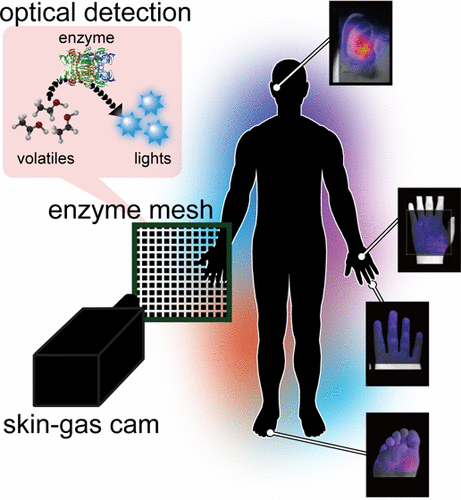Our official English website, www.x-mol.net, welcomes your
feedback! (Note: you will need to create a separate account there.)
Transcutaneous Blood VOC Imaging System (Skin-Gas Cam) with Real-Time Bio-Fluorometric Device on Rounded Skin Surface.
ACS Sensors ( IF 8.2 ) Pub Date : 2019-12-24 , DOI: 10.1021/acssensors.9b01658 Kenta Iitani 1, 2, 3 , Koji Toma 3 , Takahiro Arakawa 3 , Kohji Mitsubayashi 3
ACS Sensors ( IF 8.2 ) Pub Date : 2019-12-24 , DOI: 10.1021/acssensors.9b01658 Kenta Iitani 1, 2, 3 , Koji Toma 3 , Takahiro Arakawa 3 , Kohji Mitsubayashi 3
Affiliation

|
A skin-gas cam that allows continuous imaging of transcutaneous blood volatile organic compounds (VOCs) emanated from human skin was developed. The skin-gas cam is able to reveal the relationship between the local skin conditions and transcutaneous blood VOCs in the field of volatile metabolomics (volatolomics). A ring-type ultraviolet (UV) light-emitting diode was mounted around a camera lens as an excitation light source, which enabled the simultaneous excitation and imaging of fluorescence. A nicotinamide adenine dinucleotide (NAD)-dependent alcohol dehydrogenase (ADH) was used to detect ethanol as a model sample. When gaseous ethanol was applied to an ADH-immobilized mesh that was wetted with an oxidized NAD solution placed in front of the camera, a reduced form of NAD (NADH) was produced through an ADH-mediated reaction. NADH emits fluorescence by UV excitation, and thus, the concentration distribution of ethanol was visualized by measuring the distribution of the fluorescence light intensity from NADH on the ADH-immobilized mesh surface. In this study, a new gas application method that mimicked the release mechanism of transcutaneous gas for quantification of the transcutaneous gas concentration was evaluated. Also, spatiotemporal changes of transcutaneous ethanol for various body parts were measured. As a result, we revealed a relationship between local skin conditions and VOCs that could not be observed previously. In particular, we demonstrated the facile measurement of transdermal gases from around the ear where capillaries are densely distributed below a thin stratum corneum.
中文翻译:

经皮血液VOC成像系统(Skin-Gas Cam),在圆形皮肤表面上配有实时生物荧光仪。
开发了一种皮肤气体凸轮,可以连续成像从人皮肤发出的经皮血液中的挥发性有机化合物(VOC)。皮肤气体凸轮能够揭示挥发性代谢组学(挥发组学)领域中局部皮肤状况与经皮血液VOC之间的关系。环形紫外(UV)发光二极管安装在作为激发光源的相机镜头周围,可以同时激发和成像荧光。使用烟酰胺腺嘌呤二核苷酸(NAD)依赖性酒精脱氢酶(ADH)检测乙醇作为模型样品。当将气态乙醇应用于固定在ADH上的网状物上时,该网状物被放置在相机前面的氧化NAD溶液弄湿了,通过ADH介导的反应生成了还原形式的NAD(NADH)。NADH通过紫外线激发而发出荧光,因此,通过测量固定在ADH上的网眼表面上来自NADH的荧光强度的分布来可视化乙醇的浓度分布。在这项研究中,评估了一种新的气体施加方法,该方法模仿了经皮气体的释放机理,用于定量经皮气体的浓度。此外,还测量了人体各个部位经皮乙醇的时空变化。结果,我们发现了以前无法观察到的局部皮肤状况和VOC之间的关系。特别是,我们证明了从耳周围透皮气体的简便测量方法,在该处,毛细血管密集分布在角质层下方。通过测量来自NADH的荧光强度在固定化ADH的网状表面上的分布来可视化乙醇的浓度分布。在这项研究中,评估了一种新的气体施加方法,该方法模仿了经皮气体的释放机理,用于定量经皮气体的浓度。此外,还测量了人体各个部位经皮乙醇的时空变化。结果,我们发现了以前无法观察到的局部皮肤状况和VOC之间的关系。特别是,我们证明了从耳周围透皮气体的简便测量方法,在该处,毛细血管密集分布在角质层下方。通过测量来自NADH的荧光强度在固定化ADH的网状表面上的分布来可视化乙醇的浓度分布。在这项研究中,评估了一种新的气体施加方法,该方法模仿了经皮气体的释放机理,用于定量经皮气体的浓度。此外,还测量了人体各个部位经皮乙醇的时空变化。结果,我们发现了以前无法观察到的局部皮肤状况和VOC之间的关系。特别是,我们证明了从耳周围透皮气体的简便测量方法,在该处,毛细血管密集分布在角质层下方。评价了一种新的气体施加方法,该方法模仿了经皮气体的释放机理,用于定量经皮气体的浓度。此外,还测量了人体各个部位经皮乙醇的时空变化。结果,我们发现了以前无法观察到的局部皮肤状况和VOC之间的关系。特别是,我们证明了从耳周围透皮气体的简便测量方法,在该处,毛细血管密集分布在角质层下方。评价了一种新的气体施加方法,该方法模仿了经皮气体的释放机理,用于定量经皮气体的浓度。此外,还测量了人体各个部位经皮乙醇的时空变化。结果,我们发现了以前无法观察到的局部皮肤状况和VOC之间的关系。特别是,我们证明了从耳周围透皮气体的简便测量方法,在该处,毛细血管密集分布在角质层下方。我们揭示了以前无法观察到的局部皮肤状况和VOC之间的关系。特别是,我们证明了从耳周围透皮气体的简便测量方法,在该处,毛细血管密集分布在角质层下方。我们揭示了以前无法观察到的局部皮肤状况和VOC之间的关系。特别是,我们证明了从耳周围透皮气体的简便测量方法,在该处,毛细血管密集分布在角质层下方。
更新日期:2019-12-26
中文翻译:

经皮血液VOC成像系统(Skin-Gas Cam),在圆形皮肤表面上配有实时生物荧光仪。
开发了一种皮肤气体凸轮,可以连续成像从人皮肤发出的经皮血液中的挥发性有机化合物(VOC)。皮肤气体凸轮能够揭示挥发性代谢组学(挥发组学)领域中局部皮肤状况与经皮血液VOC之间的关系。环形紫外(UV)发光二极管安装在作为激发光源的相机镜头周围,可以同时激发和成像荧光。使用烟酰胺腺嘌呤二核苷酸(NAD)依赖性酒精脱氢酶(ADH)检测乙醇作为模型样品。当将气态乙醇应用于固定在ADH上的网状物上时,该网状物被放置在相机前面的氧化NAD溶液弄湿了,通过ADH介导的反应生成了还原形式的NAD(NADH)。NADH通过紫外线激发而发出荧光,因此,通过测量固定在ADH上的网眼表面上来自NADH的荧光强度的分布来可视化乙醇的浓度分布。在这项研究中,评估了一种新的气体施加方法,该方法模仿了经皮气体的释放机理,用于定量经皮气体的浓度。此外,还测量了人体各个部位经皮乙醇的时空变化。结果,我们发现了以前无法观察到的局部皮肤状况和VOC之间的关系。特别是,我们证明了从耳周围透皮气体的简便测量方法,在该处,毛细血管密集分布在角质层下方。通过测量来自NADH的荧光强度在固定化ADH的网状表面上的分布来可视化乙醇的浓度分布。在这项研究中,评估了一种新的气体施加方法,该方法模仿了经皮气体的释放机理,用于定量经皮气体的浓度。此外,还测量了人体各个部位经皮乙醇的时空变化。结果,我们发现了以前无法观察到的局部皮肤状况和VOC之间的关系。特别是,我们证明了从耳周围透皮气体的简便测量方法,在该处,毛细血管密集分布在角质层下方。通过测量来自NADH的荧光强度在固定化ADH的网状表面上的分布来可视化乙醇的浓度分布。在这项研究中,评估了一种新的气体施加方法,该方法模仿了经皮气体的释放机理,用于定量经皮气体的浓度。此外,还测量了人体各个部位经皮乙醇的时空变化。结果,我们发现了以前无法观察到的局部皮肤状况和VOC之间的关系。特别是,我们证明了从耳周围透皮气体的简便测量方法,在该处,毛细血管密集分布在角质层下方。评价了一种新的气体施加方法,该方法模仿了经皮气体的释放机理,用于定量经皮气体的浓度。此外,还测量了人体各个部位经皮乙醇的时空变化。结果,我们发现了以前无法观察到的局部皮肤状况和VOC之间的关系。特别是,我们证明了从耳周围透皮气体的简便测量方法,在该处,毛细血管密集分布在角质层下方。评价了一种新的气体施加方法,该方法模仿了经皮气体的释放机理,用于定量经皮气体的浓度。此外,还测量了人体各个部位经皮乙醇的时空变化。结果,我们发现了以前无法观察到的局部皮肤状况和VOC之间的关系。特别是,我们证明了从耳周围透皮气体的简便测量方法,在该处,毛细血管密集分布在角质层下方。我们揭示了以前无法观察到的局部皮肤状况和VOC之间的关系。特别是,我们证明了从耳周围透皮气体的简便测量方法,在该处,毛细血管密集分布在角质层下方。我们揭示了以前无法观察到的局部皮肤状况和VOC之间的关系。特别是,我们证明了从耳周围透皮气体的简便测量方法,在该处,毛细血管密集分布在角质层下方。











































 京公网安备 11010802027423号
京公网安备 11010802027423号